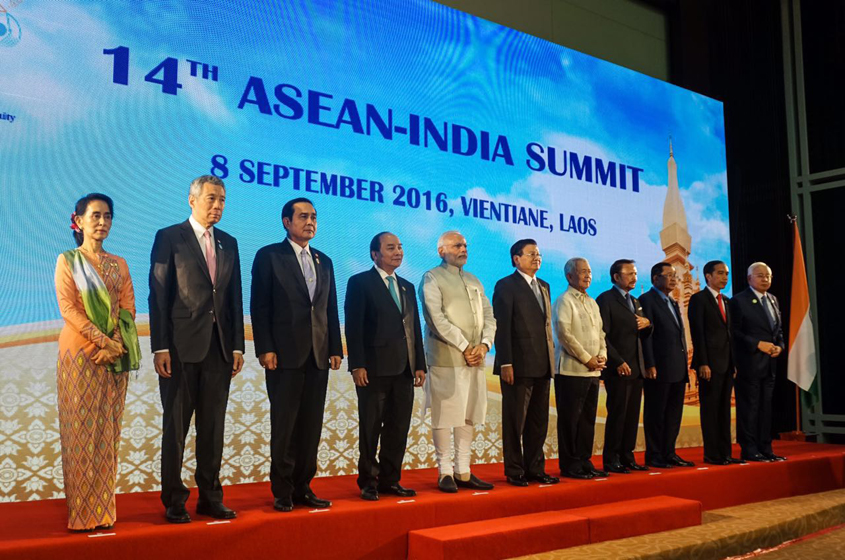 In an attempt to revive and further strengthen engagement with its eastern neighbours, India has been taking several steps, particularly with the Narendra Modi government’s enunciation of the Act East policy.
In an attempt to revive and further strengthen engagement with its eastern neighbours, India has been taking several steps, particularly with the Narendra Modi government’s enunciation of the Act East policy.
The Bay of Bengal Initiative for Multi-Sectoral, Scientific and Technical and Economic Cooperation (BIMSTEC) has completed 20 years of its existence in 2017. The eighth ministerial meeting of BIMSTEC was held in Kathmandu, Nepal on 11 August. External Affairs Minister Sushma Swaraj was present at the meeting, where she had discussions with the Bhutanese Foreign Minister on Doklam on the sidelines. In her statement at the 15th BIMSTEC Ministerial Meeting Sushma Swaraj stated: “BIMSTEC enjoys the unique strengths of connecting South and South-East Asia. It links the ecologies of the Himalayas and the Bay of Bengal. With shared histories, values and ways of life, it is the natural platform to build our common future. BIMSTEC represents our common desire for peace and development…For India, BIMSTEC is a natural choice to fulfil our key foreign policy priorities of ‘Neighbourhood First’ and ‘Act East’.”
Earlier, on 5 August, the Foreign Ministers of ASEAN met to participate in the 50th ASEAN Ministers Meeting. Subsequently, ASEAN leaders and their friends from the region and elsewhere gathered to participate in a series of annual meetings that are being held in Manila, the capital city of the Philippines. On 6 August, the ASEAN-India Foreign Ministers Meeting was held, in which the Indian side was represented by the Minister of State for External Affairs, General V.K. Singh, who, during his address, highlighted the centrality of ASEAN in Indian diplomatic and strategic calculus in the region, manifested in the form of Act East Policy.
Gen Singh stated, “From the Indian perspective, ASEAN occupies a central place in the security architecture of the Asia-Pacific region. It is our view that precisely because ASEAN represents the cultural, commercial, and physical cross-roads of the region, it has a unique ability to reflect and harmonise larger interests of the world beyond it.”
Twenty-five years ago, when India was gearing itself up to embark on a journey to engage Southeast Asia, and subsequently the East Asian countries on economic, diplomatic and strategic fronts, at both bilateral and multilateral fronts, the Southeast Asian countries turned out as friends, who enthusiastically engaged India on all counts. Not that India’s linkages had cut off with these countries, but the diplomatic milieu had changed in the post-Cold War world, and the very countries that were the factors behind the setting up of the Association of Southeast Asian Nations (ASEAN) as an anti-communist bloc, were getting closer to ASEAN with each passing day.
Under such circumstances, India needed to relook at the Southeast Asian region and redefine its role, and partnership with ASEAN. The ASEAN members, particularly Singapore, Malaysia, Indonesia, and Thailand, turned out to be the anchors in ensuring India’s multifarious engagement with the region.
Innovative ideas of the Singapore government and its leaders, such as oraganising the “India Fever”, led to revitalisation of interest in Indian culture and economy. It is no coincidence that, 25 years later, when India and ASEAN are celebrating the silver jubilee of their engagement, Foreign Secretary S. Jaishankar chose the same place to highlight the achievements of India’s Look and Act East Policy.
In the span of 25 years, the ASEAN-India dialogue mechanism has grown to host 30 dialogue mechanisms, including an annual summit and seven ministerial dialogues, covering a range of domains—strategic, political, economic and cultural. Bilateral trade has crossed the US$60 billion mark and ASEAN has become one of the most important trade and investment destinations for India.
In the span of 25 years, the ASEAN-India dialogue mechanism has grown to host 30 dialogue mechanisms, including an annual summit and seven ministerial dialogues, covering a range of domains—strategic, political, economic and cultural. Bilateral trade has crossed the US$60 billion mark and ASEAN has become one of the most important trade and investment destinations for India.
India’s stakes in the oil and gas fields off the coast of Vietnam have added a new impetus to India’s presence from a commercial and trade point of view. There is a need to further accentuate India’s trade with the ASEAN member countries. Working towards an early realisation of the Regional Comprehensive Economic Partnership (RCEP) would enable India in having greater access to the region. The India-ASEAN Free Trade Agreement, which now comprises both trade in goods and services, is another significant achievement for ASEAN-India ties. India needs to catch up with other stakeholders, both in terms of RCEP negotiations and physical and digital connectivity with the Southeast Asian region. In order to further boost ASEAN-India ties, Prime Minister Narendra Modi has already decided to host the ten leaders of the ASEAN countries as chief guests for the Republic Day celebrations in 2018.
Looking ahead, it is clear that ASEAN-India ties have to move to the next level to enable these in taking a quantum leap. Twenty-five years on, the time has come when India and the ASEAN member countries need to think out of the box again, to redefine their roles in shaping the future trajectory of the region. India and ASEAN have to chart out a comprehensive agenda comprising the issues of mutual gains and challenge. There is a need to understand what India and ASEAN should work towards in quantifiable terms. This, naturally, has to be in conformity with their own understanding of their roles in the region, and what they expect from each other.
Dr Rahul Mishra is a New Delhi based strategic affairs expert.

